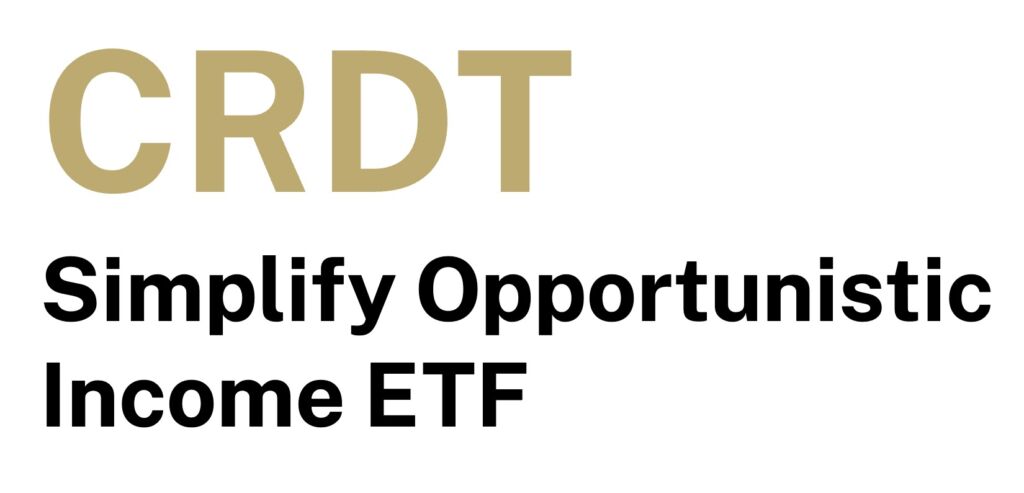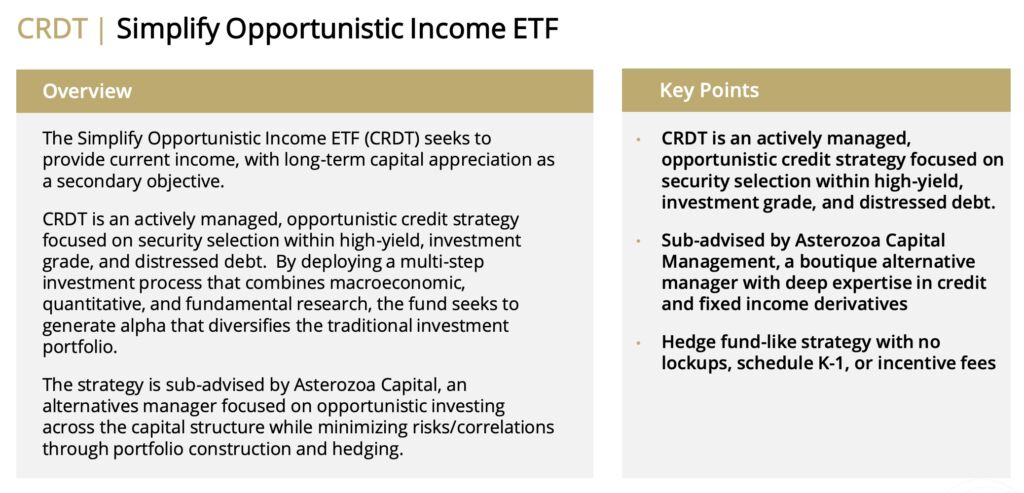One of the main reasons I started Picture Perfect Portfolios was to expand my knowledge as an investor.
There are many subject areas that I’m eager to learn more about.
One of those is high yield credit with regards to event-driven and opportunistic investing strategies.
Thus, I’m thrilled to welcome Joe Hegener of Asterozoa to discuss CRDT ETF.
It’s better known as Simplify Opportunistic Income ETF.
We’ll delve into the workings of a dynamic credit strategy that centers on choosing securities within high-yield, investment-grade, and distressed debt sectors by utilizing a comprehensive investment approach that blends macroeconomic insights, quantitative analysis, and in-depth fundamental research.
Without further ado, let’s turn things over to Joe.

Meet Asterozoa Management
Asterozoa Management is an SEC Registered Investment Manager and advisory firm specializing in bespoke solutions and differentiated alternative strategies. Joe Hegener founded Asterozoa in 2021 after tenure as the CIO of an event-driven hedge fund. Prior to running the predecessor fund, Joe gained experience across all asset classes by working on trading and advisory desks at BlackRock and PIMCO. Responsibilities included analytics, quantitative modeling, advisory, and portfolio management.
Asterozoa is the subadvizor for the Simplify Opportunistic Income ETF, CRDT, offered by Simplify ETFs.

Reviewing The Strategy Behind CRDT ETF (Simplify Opportunistic Income ETF)
Hey guys! Here is the part where I mention I’m a travel content creator! This “The Strategy Behind The Fund” interview is entirely for entertainment purposes only. There could be considerable errors in the data I gathered. This is not financial advice. Do your own due diligence and research. Consult with a financial advisor.

These asset allocation ideas and model portfolios presented herein are purely for entertainment purposes only. This is NOT investment advice. These models are hypothetical and are intended to provide general information about potential ways to organize a portfolio based on theoretical scenarios and assumptions. They do not take into account the investment objectives, financial situation/goals, risk tolerance and/or specific needs of any particular individual.
What’s The Strategy Of CRDT ETF?
For those who aren’t necessarily familiar with an “opportunistic credit strategy” style of asset allocation, let’s first define what it is and then explain this strategy in practice by giving some clear examples.
CRDT’s opportunistic credit strategy is designed to manage a balanced and/or hedged portfolio that both builds strategic income positions, and takes advantage of market dislocations when they occur. We seek idiosyncratic, high-yield drivers of return, while striving to maintain liquidity and lower volatility in the portfolio by using both structural derivative overlays, and a barbelled liquidity and risk approach.
These unique return drivers are often based on idiosyncratic events, specific to a security or company’s capital structure, and are often less correlated to market beta, thus providing complimentary exposure within a diversified fixed income basket.
One example of an opportunity that we previously identified is the $575mm convertible bond issuance of LendingTree. This note, due in 2025, is the only corporate bond on their balance sheet (with a $247mm term loan and an additional $200mm of available revolver capacity). The bond traded for 77c on the dollar with a 14% YTM. The business maintains 93% gross margins with strong operational leverage, no meaningful competition, and robust cash flow generation.
Additionally, the company has been proactively taking advantage of the cheap price by buying its own debt back for three quarters of the cost at maturity – effectively retiring the debt load from the original $575mm outstanding down to $384mm today. While this is undoubtedly an encouraging sign, and a strong signal from management, it is counter-intuitive that this very phenomenon could lead a passive fund to sell down the name, given the smaller amount of debt outstanding.
To this point, it’s worth remembering that passive credit indices often more heavily weigh the largest issuers of debt (DISH, CVNA, etc.) within the portfolio for liquidity purposes. This is similar to the market cap weighting effect of passive equity indices, except in the case of credit it leads to massive amounts of adverse selection bias that we seek to avoid.
This example illustrates why opportunistic and active security selection can allow CRDT to potentially capitalize on significant alpha availability, that passive, or many larger funds can’t.


Unique Features Of Simplify Opportunistic Income Fund CRDT ETF
Let’s go over all the unique features your fund offers so investors can better understand it. What key exposure does it offer? Is it static or dynamic in nature? Is it active or passive? Is it leveraged or not? Is it a rules-based strategy or does it involve some discretionary inputs? How about its fee structure?
What makes CRDT unique is that it is truly an unconstrained discretionary strategy, allowing the portfolio management team to both build, or hedge, exposure wherever the perceived risk-reward dynamic is the most compelling. It also allows the team to get closer to optimal portfolio diversification and risk reduction through low correlated exposures and relative-value based opportunities.
The strategy is naturally dynamic in nature and will often take a contrarian approach to some of the more crowded drivers of market beta. The Asterozoa team is particularly well suited to run this strategy given our backgrounds in capital structure arbitrage, investment banking, credit research, and multi-asset quantitative modeling.
CRDT is an actively managed fund that utilizes a unique hedge fund style strategy in an ETF structure. The Fund is focused on discretionary security selection within a broad opportunity set including high yield, investment grade, preferreds, convertibles, and distressed debt. The Fund generally employs a barbell approach to liquidity and risk, designed with dynamic hedges against market risk and beta exposure.
The Fund may implement macro hedging overlays with derivatives such as interest rate swaps, U.S. Treasury futures, and credit default swaps, to drive returns and mitigate drawdowns related to interest rate and credit spread sensitivities.
The fund’s operating fees are 0.95% annually. However, since we are new, we are currently offering a fee waiver of 0.45% until the fund has a longer track record.


What Sets CRDT ETF Apart From Other High Yield Funds?
How does your fund set itself apart from other “high-yield, investment grade, and distressed debt” funds being offered in what is already a crowded marketplace? What makes it unique?
The Fund is designed to have lower downside capture and potentially higher upside capture than competitor funds via our barbell-style approach. As a smaller fund, CRDT also has more flexibility to make strategic investment decisions through its active security selection process that combines macro, quantitative, and fundamental research layers.
The Fund can remain patient and hold dry powder when the market is tight, and deploy opportunistically as spreads widen. As defaults tick up, the Fund can slowly deploy dry powder into high-conviction credit opportunities and look to “lock-in” double digit yields over a longer duration.
As credit stress eases, the Fund will definitionally be more fully invested into these types of opportunities and therefore capture more of the upside in that market beta. There is a similar approach to macro overlays and portfolio hedges that are also employed to reduce the portfolio’s “left tail” and ideally add alpha.

What Else Was Considered For CRDT ETF?
What’s something that you carefully considered adding to your fund that ultimately didn’t make it past the chopping board? What made you decide not to include it?
Asterozoa uses a multi-step underwriting process when evaluating portfolio additions:
1. Macro
2. Quantitative (trade structure)
3. Quantitative (portfolio)
4. Fundamental
All investments need to pass this modeled criteria to be incorporated into the portfolio. We looked hard (and have held a close eye for some time) at mREITs like NLY and AGNC. These companies are frequently used in income portfolios to juice cash yields. We also looked at AT1s in the aftermath of the Credit Suisse contingent convertible bond wipeout.
While both of these asset classes presented the potential for high yields, the opportunities did not pass our criteria. The mREITs did not pass our fundamental analysis, and we correctly predicted the necessity for dividend cuts on the common shares. The AT1s did not pass our quantitative portion of underwriting.
While we see additional complete write-downs of these bank notes as unlikely, there was no effective way to hedge that risk or reduce that left tail profile (keep in mind the equity atypically received a recovery in the CS debacle even though the bonds received zero). Typically, CRDT will look to hedge riskier positions via puts or shorts on securities that are lower in the capital stack when underwriting distressed opportunities.
As it relates to AT1s, a hedge of that nature was clearly not an option in the case of CS. Other opportunities we may pass on are “1L” term loans that are not actually backed by recoverable assets. For example, the CLO market is rife with loans that are sold as “first lien,” but for distressed businesses in “asset-light” sectors like SAAS, your first position doesn’t matter much when there is nothing to recover.

When Will CRDT ETF Perform At Its Best/Worst?
Let’s explore when your fund/strategy has performed at its best and worst historically or theoretically in backtests. What types of market conditions or other scenarios are most favourable for this particular strategy? On the other hand, when can investors expect this strategy to potentially struggle?
Historically, opportunistic strategies similar to ours have performed best in times of macroeconomic unrest that create market dislocations and opportunities. Given the current environment, we see opportunities in credit that were otherwise unavailable for the majority of the last 15 years. Asterozoa’s investment team has deep expertise in credit and fixed income derivatives.
Liquidity shocks will inevitably create substantial markdowns in the higher-risk long portion of our book. Periods where the fund may underperform could be when correlations are muddled, and portfolio hedges or macro overlays are less effective than modeled at dampening our risk on the long end. These bouts or shocks may create near term mark to market losses, but will also be substantial opportunities for our barbelled strategy to deploy dry powder into high conviction investments.

Why Should Investors Consider Simplify Opportunistic Income Fund CRDT ETF?
If we’re assuming that an industry standard portfolio for most investors is one aligned towards low cost beta exposure to global equities and bonds, why should investors consider your fund/strategy?
Looking at several of the most popular/largest fixed income ETFs, outside of the index-related rules to entry, there is (by design) zero analytical review of the actual business or quality of the balance sheet when one of these funds purchases bonds. For example, DISH is a household name that is notoriously losing market share to more competitive business models driven by cord cutting, and the legacy nature of its technology.
In 2023, DISH is projected to lose $1.2bn in cash flow, with an additional $1.3bn loss projected for 2024. In fact, analysts and firm guidance is not projecting any semblance of cash flow profitability for at least the next five years. DISH has $21.25 billion dollars of corporate debt on its balance sheet, 60% of which is unsecured. This business – which has been in steady decline for years – has ~10x more long-term debt than they have cash on hand currently… and they are projected to chew through their available cash in the next 18mo of operations. Despite the awful fundamentals, DISH is one of the largest issuer concentrations in HYG, almost entirely due to the amount of available debt outstanding.
CRDT offers an alternative to the negatively asymmetric risks in passive credit investing. Focusing on credit selection and incorporating hedging frameworks, the Fund seeks to deliver yield and alpha, rather than performance driven by a “rising tide” in broader financial market beta.

How Does CRDT ETF Fit Into A Portfolio At Large?
Let’s examine how your fund/strategy integrates into a portfolio at large. Is it meant to be a total portfolio solution, core holding or satellite diversifier? What are some best case usage scenarios ranging from high to low conviction allocations?
The Fund is a core holding that seeks to serve as a thoughtful substitute for passive high-yield credit exposure, offering compelling upside while mitigating downside exposure to market pullbacks through the use of derivatives and other hedging strategies.
We believe passive and even some other active strategies do not adequately compensate investors for the risks assumed and are too narrow in their focus to offer compelling risk/reward ratios.
CRDT presents an optimal alternative for investors looking for the safety of fixed income, but also attractive total returns for risks taken.

The Cons of CRDT ETF
What’s the biggest point of constructive criticism you’ve received about your fund since it has launched?
Classification. A fund with such a large array of tools at its disposal can sometimes be difficult for allocators that are trying to rigidly model a suite of fixed income products within a broader portfolio.
Some allocators want specific exposure (say, to exclusively BB CLOs) so they can more reliably incorporate it into their models.
Our portfolio is much more dynamic, and therefore more difficult to use predictive or scenario analysis when only observing the historical exposures or performance.

The Pros of CRDT ETF
On the other hand, what have others praised about your fund?
It contains a unique blend of exposures that are not traditionally seen within the same ETF. Our background in quantitative modeling – specifically, scenario analysis and multi-asset risk – is a clear differentiator in active credit, and can lead to some “outside the box” exposure optimizations.
Our macro overlays, portfolio hedges, and even security selections within distressed credit have all added alpha QTD – all while we continue to maintain a 8% yielding credit fund. These unique overlays are what has contributed to our 300bps of outperformance versus our benchmarks.
Learn More About CRDT ETF
We’ll finish things off with an open-ended question. Is there anything that we haven’t covered yet that you’d like to mention about your fund/strategy? If not, what are some other current projects that you’re working on that investors can follow in the coming weeks/months?
There are some major macro catalysts on our horizon, and we are actively working on how to thoughtfully position ourselves in order to best navigate the ensuing volatility. We hope and pray for a resolution to the war in Ukraine. There is also potential for a very heated election cycle next year.
Enormous geopolitical and fiscal shifts in Europe, China, Japan, LatAm, and the MidEast; which have large implications for the USD and multinationals. Inflation and the Fed rate trajectory is obviously on top of everyone’s mind in markets. These are all potentially structural market drivers of fund flows and therefore returns.
We are already seeing interesting pockets of the market that we believe are overlooked and provide compelling value on a risk/return basis. At the same time, we see huge opportunities in building both high yielding long positions, as well as inexpensive portfolio hedges that have the potential to add substantial alpha over the intermediate horizon. Volatility creates opportunity for those that know how to properly assess it, and have the tools to capture it.
For more information on Asterozoa, please visit https://www.asterozoacapital.com/. For more information on Simplify, Simplfiy ETFs, and CRDT, please visit https://www.simplify.us/.

Connect With Simplify ETFs
Twitter: @SimplifyAsstMgt
YouTube: Simplify Asset Management
Simplify Asset Management: Simplify ETFs
Fund Page: AGGH ETF

Connect With Asterozoa
Website: Asterozoa Capital Management
LinkedIn: Asterozoa Capital
Nomadic Samuel Final Thoughts
I want to personally thank Joe Hegener at Asterozoa and the team over at Simplify for taking the time to participate in “The Strategy Behind The Fund” series by contributing thoughtful answers to all of the questions!
If you’ve read this article and would like to have your fund featured, feel free to reach out to nomadicsamuel at gmail dot com.
That’s all I’ve got!
Ciao for now!
Important Information
Comprehensive Investment Disclaimer:
All content provided on this website (including but not limited to portfolio ideas, fund analyses, investment strategies, commentary on market conditions, and discussions regarding leverage) is strictly for educational, informational, and illustrative purposes only. The information does not constitute financial, investment, tax, accounting, or legal advice. Opinions, strategies, and ideas presented herein represent personal perspectives, are based on independent research and publicly available information, and do not necessarily reflect the views or official positions of any third-party organizations, institutions, or affiliates.
Investing in financial markets inherently carries substantial risks, including but not limited to market volatility, economic uncertainties, geopolitical developments, and liquidity risks. You must be fully aware that there is always the potential for partial or total loss of your principal investment. Additionally, the use of leverage or leveraged financial products significantly increases risk exposure by amplifying both potential gains and potential losses, and thus is not appropriate or advisable for all investors. Using leverage may result in losing more than your initial invested capital, incurring margin calls, experiencing substantial interest costs, or suffering severe financial distress.
Past performance indicators, including historical data, backtesting results, and hypothetical scenarios, should never be viewed as guarantees or reliable predictions of future performance. Any examples provided are purely hypothetical and intended only for illustration purposes. Performance benchmarks, such as market indexes mentioned on this site, are theoretical and are not directly investable. While diligent efforts are made to provide accurate and current information, “Picture Perfect Portfolios” does not warrant, represent, or guarantee the accuracy, completeness, or timeliness of any information provided. Errors, inaccuracies, or outdated information may exist.
Users of this website are strongly encouraged to independently verify all information, conduct comprehensive research and due diligence, and engage with qualified financial, investment, tax, or legal professionals before making any investment or financial decisions. The responsibility for making informed investment decisions rests entirely with the individual. “Picture Perfect Portfolios” explicitly disclaims all liability for any direct, indirect, incidental, special, consequential, or other losses or damages incurred, financial or otherwise, arising out of reliance upon, or use of, any content or information presented on this website.
By accessing, reading, and utilizing the content on this website, you expressly acknowledge, understand, accept, and agree to abide by these terms and conditions. Please consult the full and detailed disclaimer available elsewhere on this website for further clarification and additional important disclosures. Read the complete disclaimer here.





